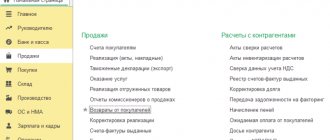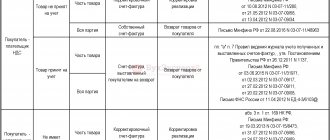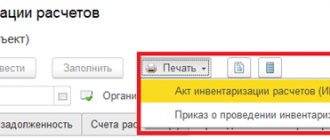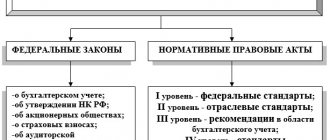Returning goods: let's get to the bottom of it
The supply of products or goods is carried out on the basis of an agreement or contract. These documents reflect the key delivery terms and requirements. If the supplier violates the agreement, then, according to the provisions of the Civil Code of the Russian Federation, the buyer has the right to refuse the purchase.
The acquirer requires under Art. 475 Civil Code:
- price reduction;
- replacement of low-quality products;
- free elimination of defects;
- additional packaging and shipment;
- or other things.
In most cases, you will have to return products that have already been shipped. To do this, draw up a return invoice to the supplier, a letter of claim and a statement of discrepancy.
IMPORTANT!
If the buyer refuses a product that does not comply with the terms of the supply agreement, he is still obliged to ensure the safety of the supplied goods and materials until return. The requirement is enshrined in Part 1 of Art. 511 of the Civil Code of the Russian Federation.
What documents are used to document the return of goods from the buyer?
In accordance with the provisions of paragraph 2 of Art. 7 of the Law of the Republic of Kazakhstan “On Accounting and Financial Reporting”, forms or requirements for primary documents used to document transactions or events are approved by the authorized body and (or) the National Bank of the Republic of Kazakhstan in accordance with the legislation of the Republic of Kazakhstan.
According to the provisions of paragraphs 3 and 3-1 of Art. 7 of the Law of the Republic of Kazakhstan “On Accounting and Financial Reporting”, individual entrepreneurs and organizations develop primary documents both on paper and electronic media, the forms or requirements for which are not approved, independently or apply forms or requirements approved in accordance with the legislation of the Republic of Kazakhstan , which must contain the following mandatory details:
1) name of the document (form);
2) date of compilation;
3) the name of the organization or the surname and initials of the individual entrepreneur on whose behalf the document was drawn up;
4) the content of the operation or event;
5) units of measurement of an operation or event (in quantitative and monetary terms);
6) names of positions, surnames, initials and signatures of persons responsible for the transaction (confirmation of the event) and the correctness of its (his) execution;
7) identification number.
Depending on the nature of the transaction or event, the requirements of the regulatory legal acts of the Republic of Kazakhstan and the method of processing accounting information, if this does not contradict the legislation of the Republic of Kazakhstan, additional details may be included in the primary documents.
Thus, the authorized body has approved only the form of the invoice for the release of inventories to the third party (Z-2), which is used when selling goods, but the authorized body has not approved the form of the return invoice issued when returning the goods from the buyer to the supplier, and therefore this form The return invoice can be used from the document in 1C “Return of goods and materials from buyers”.
Accordingly, the invoice for the release of inventory to the side (Z-2), which was issued during the initial sale, as well as the sales operation itself, does not need to be changed in 1C. When returning goods from customers, it is necessary to issue a return invoice immediately at the time of returning the goods from the buyer using a document in 1C “Return of goods and materials from customers”, during which the corresponding transactions will be generated and through which an additional ESF can be issued.
Based on the provisions of paragraph 1 of Art. 383 of the Tax Code of the Republic of Kazakhstan, when the size of turnover for the sale of goods, works and services changes in one direction or another in the cases provided for in paragraph 2 of Art. 383 of the Tax Code of the Republic of Kazakhstan, after the date of its commission, the size of the turnover is adjusted accordingly.
Taking into account the provisions of paragraph 2 of Art. 383 of the Tax Code of the Republic of Kazakhstan, adjustments to the amount of turnover are made, incl. in cases of full or partial return of goods, with the exception of the import of goods with placement under the customs procedure of re-import, previously exported with placement under the customs procedure of export.
Based on the provisions of paragraph 5 of Art. 383 of the Tax Code of the Republic of Kazakhstan, the amount of adjustment of the amount of taxable (non-taxable) turnover is included in the taxable (non-taxable) turnover of the tax period in which the date of occurrence of the cases provided for in paragraph 2 of Art. 383 of the Tax Code of the Republic of Kazakhstan. This date is the date of the turnover for the amount of the adjustment.
Those. adjustment of the amount of turnover and VAT downwards as a result of the return of goods from the buyer to the supplier LLP is reflected in the tax return of 300.00 for the quarter in which this return occurs.
Grounds for returning inventory items
It is not always possible to return goods legally. For example, if the delivery requirements are fully met and the supplier refuses to enter into an additional agreement. But there are specific situations when the return of goods and materials is legal and necessary. Let us indicate the situations when you will have to prepare a return invoice for goods and materials:
| Situation | Comments | Link to legal acts |
| Inconsistency with quality | The buyer has a choice:
| Clause 2 Art. 475 Civil Code of the Russian Federation |
| Discrepancy in scope of supply | If an undelivered part of the inventory is identified, the purchaser returns the entire shipment. If the counterparty has shipped a larger volume of goods and materials, then the excess must be returned. | Art. 466 Civil Code of the Russian Federation |
| Incomplete supplied | You require the counterparty to supply the missing parts, parts and components, or you return the entire shipment. | Art. 480 Civil Code of the Russian Federation |
| Assortment mismatch | The recipient refuses the entire shipment. However, you can only return non-conforming items and request a replacement. | Art. 468 Civil Code of the Russian Federation |
| Failure to meet delivery deadlines | The supplier violates the terms of delivery of the goods, refuse the shipment altogether. But there are exceptions for goods with a limited shelf life. | Art. 511 Civil Code of the Russian Federation |
It is not necessary to go to extreme measures and terminate the supply contract. First, require the supplier to eliminate the identified deficiencies and discrepancies. If complaints do not yield results, proceed with countermeasures.
The buyer also refuses quality goods delivered on time and in full. But for this you will have to negotiate with the supplier. In this situation, you will have to conclude an additional agreement, which will reflect the new terms of cooperation or severance of business relations.
Reasons for filling out a return invoice
The result of the concluded contract for the purchase of inventory items is the delivery of these goods. The supplier’s task is to ship goods and materials strictly in the quantity that was specified in the procurement documentation and government contract. Qualitative characteristics must comply with the agreement entered into by the parties. The main task of the customer is the acceptance and inspection of inventory items (clause 2 of article 513, clause 2 of article 474 of the Civil Code of the Russian Federation). If all qualitative and quantitative indicators comply with the government contract and specifications, the responsible representative of the customer signs the delivery note.
If a specialist representing the customer’s side identifies discrepancies in the number of batches or a discrepancy in quality, he returns the goods and materials. Please refer to the following reasons when generating return documents:
- expired - goods and materials supplied with an expired expiration date;
- poor quality - quality characteristics do not meet customer requirements;
- improper packaging - the integrity of the packaging container and the completeness of the delivery are compromised;
- new assortment - the customer has updated the assortment, and the inventory data is not included in the new list;
- impossibility of sale - the buyer is not able to use or sell these products.
The customer’s right to a refund is enshrined in the Civil Code of the Russian Federation - in Articles 475 (clause 2), 482 (clause 3), 480 (clause 2). Return documents are issued both at the time of acceptance and after the goods are registered.
Use free instructions from ConsultantPlus experts to fill out the return invoice without errors.
Which form to use
The unified form of the TORG-12 invoice was approved by Resolution of the State Statistics Committee of Russia dated December 25, 1998 No. 132. But the use of uniform forms is not necessary. The organization has the right to use its own return invoice forms. Approve the self-developed form in your accounting policy. Read on for detailed instructions on how to fill it out. Or use a unified form.
There is no need to establish the structure and rules for filling out the TORG-12 invoice form in the accounting policy of the institution. It is enough to make a link that TORG-12 is used to process the return.
IMPORTANT!
State employees use special invoice forms to reflect returns. This is an act of acceptance and transfer of objects of non-financial assets (f. 0504101) and an invoice for the release of materials (material assets) to the outside (f. 0504205). Instructions for filling out are fixed by Order of the Ministry of Finance of Russia dated March 30, 2015 No. 52n (as amended on November 17, 2017).
How to fill out a statement of discrepancy
If the customer identified discrepancies in inventory and materials during the acceptance process and did not have time to register the products and register the transactions, then the return is carried out using the following forms:
- TORG-2 - for inventory items of Russian origin;
- TORG-3 - for imported products.
In fact, this is not a return invoice, but an act in which the customer makes claims to the supplier regarding the entire delivery batch or individual types of products. The procedure for filling out the return certificate is as follows:
- Fill in the information about the customer organization, enter the address and contacts and the necessary codes according to the all-Russian classifier.
- Indicate the details of the act - its number and date.
- Fill in information about the place of delivery, the basis document (primary delivery note), the consignor and consignee, and the government contract.
- Indicate the time of receipt of the goods.
- On the second and third sheets, document the reason for the return - indicate all quantitative and qualitative discrepancies, actual and planned indicators and their discrepancies.
- The last page of the form indicates the persons responsible for shipment, delivery and acceptance. The members of the commission that identified the inconsistencies are listed. All commission members must sign. In addition to the commission, the form is signed by the chief accountant. At the end of the document, the customer’s manager makes his decision.
The rules for forming TORG-2 and TORG-3 are absolutely the same.
IMPORTANT!
Form No. 2 is used to formalize the return of domestically produced goods, and form No. 3 is used to return foreign goods.
What to do with VAT
The rules for processing documents involved in the calculation of value added tax have changed. Now the buyer who returned the goods and materials does not issue an invoice. But the supplier who accepted the return issues an adjustment invoice taking into account the actual delivery values. Then he registers the adjustment invoice in the sales book (clause 3 of article 168, clause 10 of article 172 of the Tax Code of the Russian Federation, clause 12 of the Rules for maintaining a purchase ledger, clause 1.4 of the Federal Tax Service Letter No. SD-4-3/ dated October 23, 2018) [email protected] , Letter of the Ministry of Finance dated 02/04/2019 No. 03-07-11/6171).
The buyer, if he has accepted VAT for deduction, restores the tax on the basis of the received adjustment invoice. And registers transactions in the purchase book (clause 4, clause 3, article 170 of the Tax Code of the Russian Federation, clause 1.4 of the Federal Tax Service Letter No. SD-4-3 of October 23, 2018 / [email protected] ).








